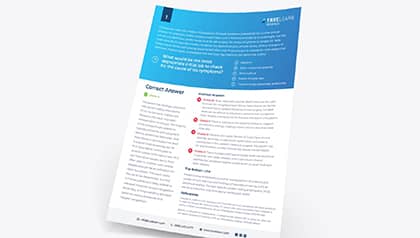Everything You Need To Know About The ABEM Qualifying Exam + Test Prep Advice
Every year in the fall, the American Board of Emergency Medicine (ABEM) administers the ABEM Qualifying exam. This exam is a crucial step for physicians wishing to become board certified in emergency medicine. The exam is rigorous, but with the right approach you can go into the exam feeling confident. In this blog, we’ll cover what you need to know to be successful!
What is the ABEM Qualifying Exam?
The ABEM Qualifying Exam is a comprehensive assessment designed to evaluate a physician’s knowledge and competency in the field of emergency medicine. It is the second out of three steps to become certified by the American Board of Emergency Medicine, in which one must first apply for certification, then pass the ABEM Qualifying exam, and finally pass the oral exam. Accomplishing all three is a distinction that signifies a high level of expertise in the specialty. The exam is designed to measure the physician’s medical knowledge and diagnostic reasoning.
ABEM QE Content and Structure
The exam is broken down into two sections referred to as “books.” You are allotted three hours and ten minutes for each book. In between each book you are given a one-hour break. Making your total time at the testing center approximately eight hours.
There are a total of 305 multiple choice questions. The questions are presented in paragraphs which may include images for you to interpret such as x-rays, ECGs, rhythm strips, ultrasounds, etc. You are given a list of commonly abbreviated items on the test as well as a list of normal lab values. The questions consist of 30% critical acuity, 40% emergent acuity, 21% low acuity, and 9% no acuity., with a mix of Pediatric (8% minimum), Geriatric (6% minimum) and Adult cases. Below is a list of the various elements on the exam along with their corresponding exam weight.
Medical Knowledge, Patient Care, and Procedural Skills
- Signs, Symptoms, and Presentations: 10%
- Abdominal and Gastrointestinal Disorders: 7%
- Cardiovascular Disorders: 10%
- Cutaneous Disorders: 3%
- Endocrine, Metabolic, and Nutritional Disorders: 5%
- Environmental Disorders: 2%
- Head, Ear, Eye, Nose, and Throat Disorders: 4%
- Hematologic Disorders: 3%
- Immune System Disorders: 2%
- Systemic Infectious Disorders: 7%
- Musculoskeletal Disorders (Non-traumatic): 3%
- Nervous System Disorders: 6%
- Obstetrics and Gynecology: 3%
- Psychobehavioral Disorders: 2%
- Renal and Urogenital Disorders: 3%
- Thoracic-Respiratory Disorders: 7%
- Toxicologic Disorders: 4%
- Traumatic Disorders: 9%
- Procedures and Skills: 8%
- Other Components: 2%
Best Ways to Prepare for the ABEM Qualifying Exam
- Create a detailed study plan. Start by taking a practice exam to assess your current knowledge. Then, using the content elements listed above, create a plan that covers all areas. Schedule dedicated time to each subject, allotting more or less time depending on your current knowledge of each area.
- Use high quality resources. Get advice from your peers on quality materials like review books and online courses.
- Practice questions are key! They are the most powerful tool you can use. When doing practice questions, you are using active recall, which helps with your knowledge retention. Be sure to always read the answer rationales, no matter if you got the question right or wrong. This really helps solidify the information. As you move along in your studies slowly increase the number of questions you are answering in each sitting. This will help to increase your testing endurance. Also be sure to take full length, timed practice exams to simulate the actual testing experience. TrueLearn’s ABEM question bank has over 1,500 questions written by content experts and is mapped to the ABEM exam blueprint.
- Consider joining or forming a study group with fellow examinees. Group discussions and peer teaching can enhance your understanding of complex topics.
- Regularly assess your progress and adjust your study plan accordingly.
How Long Do I Need to Study?
We recommend dedicating at least three months of time to study for the exam. The amount of time needed will vary based on your prior knowledge and clinical experience.
What is the Current Pass Rate?
In 2022, the first-time pass rate for the ABEM Qualifying exam was 91%. You must score a 77 or higher to pass.
What Happens if You Fail the Exam?
Failing the ABEM Qualifying Exam can be discouraging, but it’s important to remember that it’s not the end of your journey to becoming a board-certified emergency medicine physician. If you don’t pass the exam, you can retake it. Options vary based on your board eligibility, so you must log into your ABEM portal to see if there are any additional requirements before you are able to schedule a retake.
After a failed attempt, you should take some time to evaluate your performance and identify areas of weakness. Consider modifying your study plan, seeking additional resources, or possibly getting tutoring if necessary. Many candidates find success in subsequent attempts after refining their study strategies.
Top 3 Things You Need to Know If You’re Taking the ABEM Qualifying Exam
Know what to expect before, after, and the day of the exam. Visit ABEM’s website and take some time to look around and familiarize yourself with the policies and expectations of the exam.
Focus on high-yield topics. Not all topics are created equal in terms of their relevance and weight in the exam. Focus your efforts on high-yield topics that are more likely to appear on the test.
Stay calm and confident. Exam anxiety can be a significant hurdle. Ensure you get enough rest the night before the exam and try relaxation techniques to stay calm during the test. Confidence in your preparation is key.
The ABEM Qualifying Exam is an important milestone for emergency medicine physicians. The test is very challenging but with the right approach and a commitment to continuous learning, you can conquer it!

